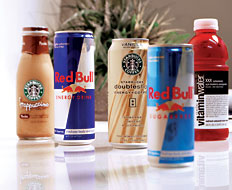McDonald’s signs boast about the incredible number of hamburgers—now many billions—it’s served over the years. But with the customer clamor for specialty beverages growing louder, the fast food icon may one day brag about the number of peppermint mochas sold.
When McDonald’s launched the McCafé line in 2009, it was both a warning signal to Starbucks and a resounding affirmation that specialty beverage menus would be a fixture at quick serves all over the country.
And signs are pointing to beverages becoming even more important to menus in coming years.
The “2010 Beverage Consumer Trend Report” by Technomic, a Chicago-based food consultancy, found that between 2008 and 2010, every type of beverage grew in incidence on the menus of the nation’s top 500 restaurants. Further, 86 percent of consumers surveyed had purchased a beverage away from home in the previous month.
While soda and milkshakes have long been staples on quick-serve menus, the rise of Starbucks in the coffee space and smoothie concepts like Jamba Juice have led to a proliferation of specialty beverages across the spectrum of flavor profiles.
“If you don’t have a blended fruit beverage, you’re not in the game right now,” says Aaron Noveshen, president of the Culinary Edge, a foodservice industry consulting firm based in San Francisco.
Noveshen points to brands like McDonald’s, Sonic, and Taco Bell, with its Frutista Freeze line, as chains that are doing specialty beverages right. From sizes small to large, quick serves have rolled out specialty beverages in droves because it is a good tactic for increasing revenue, he says.
“It’s really about incremental sales at the end of the day,” Noveshen says. “Specialty beverages can be a stand-alone product.”
With specialty beverages firmly established in the quick-service sector, industry insiders are looking ahead at what the next big thing in the space will be. The success of the McCafé and Starbucks’ continuing growth should ensure that the specialty coffee market stays vibrant. But energy-drink brands are attempting to steal market share as another way for consumers to wake themselves up in the morning.
“Quite frankly, I’m surprised energy drinks have not taken greater shape, especially in limited service,” says Darren Tristano, executive vice president at Technomic.
Tom Minella, an account leader for Red Bull’s restaurant category throughout North America, says that should happen soon. While Steak ‘n Shake is Red Bull’s lone quick-serve client, Minella says the company is hunting for more, specifically in the fast-casual sector because chains like Chipotle and Panera already have reach-in beverage coolers. “[Quick service] is absolutely a new and emerging channel for us,” Minella says. “It’s still very new in the game for us. … You’ll begin to see more activity in 2012 and it will become more mainstream in 2013.”
Tristano and others also see alcoholic beverages making further inroads into the quick-service sector. Some Burger King, Starbucks, Sonic, and Chipotle locations already serve beer in the U.S., and many brands, including McDonald’s, have long served alcohol in their European stores. It’s only a matter of time, Tristano says, until beer and wine become a common item on domestic quick-serve menus.
Susan Shields, Jamba Juice senior vice president and chief marketing officer, says health drinks like smoothies and fruit juices will continue to grow in popularity. She says ingredients that are perceived as and marketed as exotic—things like açai berries, coconut water, and certain spices—will continue to help concepts like Jamba Juice appeal to consumers looking for healthy and exciting beverages. She also says specialty teas, which figure prominently in Jamba Juice’s menu, are “definitely a trend to watch.”
Beverages with whole fruits and vegetables will continue to be popular, in part because of the average American consumer’s increasing understanding of the importance of nutritious eating.
“Everywhere you are reading about the need for a better diet to control your health and your health-care costs, and people are beginning to realize that they don’t have to eat empty calories,” Shields says. “The importance placed on health and wellness continues to rise.”
The healthy-eating trend is especially catching on with the Millennial generation, a demographic that Tristano says has latched onto specialty beverages.
Millennials are also fans of more choice and control, something a Coca-Cola representative says has made its Freestyle dispensing machine popular in the beverage space.
“[Consumers] want more offerings and the ability to create the beverages of their own making,” says Maureen Hendrix, senior channel marketing manager for Coca-Cola Refreshments.
Of all the specialty beverage trends, coffee remains the strongest and the most dynamic.
“People are more aware now that there is a better cup of coffee,” says Jenny McCabe, director of communications and PR for Seattle’s Best Coffee, a wholly owned subsidiary of Starbucks.
Seattle’s Best has distribution partnerships with Subway and Burger King, and is also in the process of testing with Taco Bell.
“A [quick serve] is a great place to deliver a really yummy, sweet coffee beverage, but to do it in a way that’s coffee-forward,” McCabe says.
With brands fully invested in the coffee market, it will doubtlessly remain the specialty beverage of choice for the foreseeable future, even if McDonald’s isn’t bragging about mocha sales on its signs just yet.











